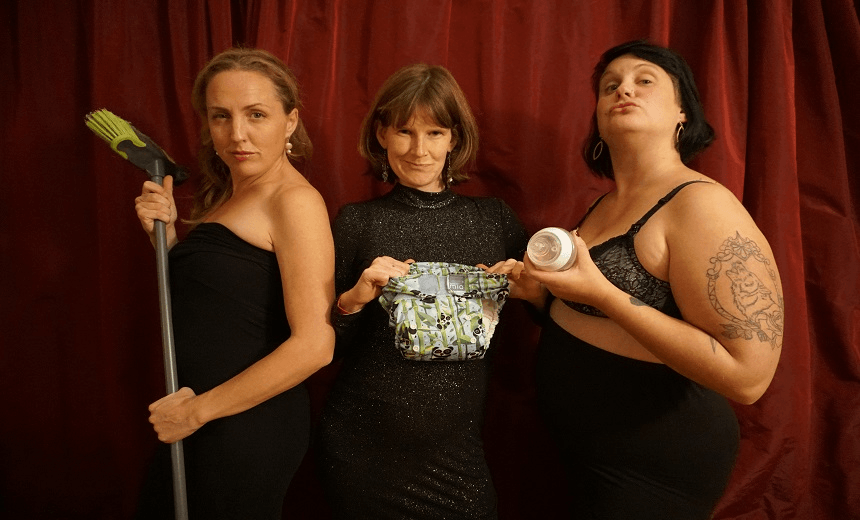A theatre show written by parents and for parents is welcoming mums to see the show with their babies. It might be a first in New Zealand. Producer Rachel Millar outlines why they’ve made the decision to be accessible.
After children and babies in cafes and children on planes, babies in the theatre is the horrific urban myth that always pops up in discussions about accessibility. Certain people who want public spaces to be free of children always have a tale about how they were at a cafe and a group of children attacked the wait staff like Lord of the Flies as their grinning mothers cheered them – but a story about the theatre is never far off.
There are claims of shows being ruined by screaming babies, their mothers beaming in delight that they are ruining everything for the other audience members. Never verified. No citation needed. It’s always an interesting claim because I don’t know any mothers with newborns who are awake for a 9pm screening, or any with older children who would want to take them to a 9pm showing of Puppetry of the Penis. But still, people insist it has happened.
Earlier this week I read Linda Jane Keegan’s column about the lack of child-friendly public places and it struck a chord, as it did for many parents I know. As a primary caregiver to an infant, I don’t often go to the theatre, or to comedy shows, or to talks.
Why not? Because I’m the primary caregiver of an infant. Yeah, it’s that simple.
I don’t know of any recent show or performance for adults that has allowed babes in arms. Even the World of Wearable Art show, which is full of the sort of costumes that would entertain my baby for hours, told me that I would have to buy him a full price $50 ticket if I really wanted to bring him (despite the fact that he would not actually be in a seat).
So why isn’t there more flexibility?
Having a baby hasn’t suddenly changed my desire to go to cultural events, in fact if anything I want to go more. I spent most of the first year of my son’s life with him – a year with a child who didn’t speak, or with other parents whose children didn’t yet speak.
Aside from the weekly baby cinema screenings, parents with young children – and single parents even more so – are excluded from cultural activities.
As with any discussion about making spaces more friendly to sole caregivers, I need to make that boring justification: I am not advocating taking babies everywhere. Not at all. I’m now back at work and skip out of the door on workdays delighted at the prospect of going to the toilet on my own and having a coffee while leafing through the newspaper in my lunch break.
But if you have a newborn, are breastfeeding, or a single parent, it can be very difficult to leave the kid at home. And that’s why new parents so often miss out on the cultural events in their area.
Nobody is suggesting children should go to adult shows at night. Nobody is suggesting children should go to shows with adult themes or violence. Nobody is advocating that a toddler going through a biting stage attends a midnight dress-up of Rocky Horror. But surely we can talk about what mothers of babies actually want: the chance to see a performance with their baby on their lap feeding or sleeping. Sure, they may cry, but I guarantee a mother is going to be more stressed about this than anyone else in the audience. They’ll likely smother them with a boob or be out of there in three seconds flat. The myth of the mother who delights in having a child scream for hours during a theatre show is just that – a myth.
So, when a parent friend of mine, Fingal Pollock, told me she was creating a comedy show called Femme Natale, by parents and for parents, I couldn’t wait to be involved. I was even more excited to find out there’s a ‘relaxed’ matinee performance where parents can bring their babes in arms. For free. And they won’t get stares. Or tuts. They’ll be *gasp* welcome.
Fingal says the idea behind the baby-friendly matinee was to give mums who couldn’t get out at night – or whose babies were so young they couldn’t be left for an hour – an opportunity to see the show. So, along with BATS Theatre in Wellington, she’s leading the way.
Hopefully this show will inspire others to follow suit. Imagine more performances that welcomed mothers! More cultural experiences, more opportunities to be out in the world with others instead of confined to home!
Femme Natale is a raucous comedy that is about motherhood (note – not for children!). The cast is entirely made up of parents; Fingal herself has two young children and the rehearsal process has been entirely flexible, scheduled around the needs of babies and the schedules of mothers. Maybe that’s why they made plans from the get go to welcome primary caregivers into the audience.
Mothers (and one token dad!) have written the skits, directly derived from their own experiences of parenthood, which are truthful and personal, with a comic twist. And you can watch it all with your baby snoozing on your lap.
Follow the Spinoff Parents on Facebook and Twitter.
